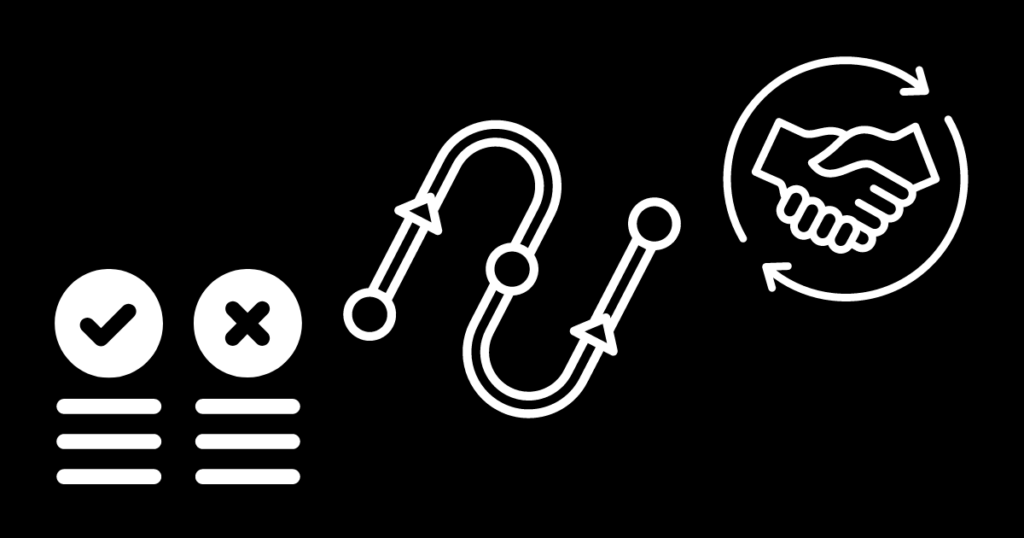There are 4 key elements to the perfect client-designer relationship that leaves both parties happy with the project. As with any relationship, these items are a two-way street for a give-and-take built on trust and expertise.
If both you and your designer are able to achieve these points (plus a bonus point!), your project will be done well, in a timely manner, and with the rosy glow of a satisfying interaction.
Client-Designer Relationship Goals
When we talk about the perfect client-designer relationship, we’re not talking about a list of items we expect our clients to perform in order for us to work with them. In fact, we’re trying to avoid a power play from either side. We’re talking about a quid pro quo, You Do This and We’ll Do It Too for A Great End Result type of relationship.
The goal is to speak candidly, trust each other to do our respective jobs, and work together towards the finished result. What we’re trying to avoid is one or the other pushing or pulling the other toward the end result.

You’ll Pay On Time, We’ll Deliver On Time
It feels crass to put it so bluntly, but the first key to a partnership that leaves people happy is deadlines being met. This goes both ways. Your designer is doing this to pay their bills, and as such needs to be compensated for their work in a timely manner so they’re able to do so.
On the flip side, you are paying good money for services rendered and expect to not be waiting for 6 months on a project that should have taken 2 weeks.
In a dysfunctional client-designer relationship, resentment builds, leading to deadlines being pushed back. Either a designer digs their heels in and (possibly rightly) says, “I will not do any more work until I’m paid for what I’ve done.” Or, the client will say, “It has taken me too long to see progress on this project, so I will not make another payment until I see more.”
If this does happen, ideally the person who dropped the ball will simply pick it back up and the project will continue. After all, things happen and sometimes things slip through the cracks.
However, this scenario often leads to a chicken and the egg scenario, where both parties feel they’re in the right and need the other to budge before they will. The project grinds to a halt. Inevitably client and designer part ways, and neither has a good review of working with the other.
It’s best to avoid it altogether and simply both follow through on the agreements made. Or, at the very least, accept responsibility if a mistake has been made, and make it right.
Timely (And Clear) Communication
A project killer we see a lot of is lack of communication. For instance, when a designer is waiting on content, a project cannot move forward. However, if the client doesn’t know what exactly it means to provide content, they will often put it off until the project dies. In the ideal relationship, a client will feel comfortable asking what that means and your designer will be able to spell out exactly what they need to complete your website/brochure/whatever.
Projects are done most efficiently when emails and phone calls are answered (or promptly returned). The laws of physics very much so apply to graphic design, and objects in motion stay in motion. Once a proof/question/clarification has gone unanswered for long enough, regardless of where it stopped, the chances of it ever being finished begin to drop.
Plus, how annoying is it when you can’t get a hold of your designer? We feel the same way when we go unanswered.
No Micromanaging On Either Part
You have your expertise – that’s why you do what you do. We have ours – that’s why we do what we do. When each bit of our job is micromanaged by our clients, it leads to frustration on both parts. That’s not to say we don’t welcome feedback or that you’re expected to accept a design you hate.
It simply means we have a way of doing things for a reason. If your goal was to build a website to sell products, we chose a design that will perform that function, even if it doesn’t look exactly like you envisioned it.
In exchange, we promise to not criticize the decisions you make.
We pride ourselves in our ability to build relationships with our clients built on trust. We love to recommend products and services and give suggestions that we’ve seen work. However, if you have real concerns about the design, please raise them. For instance, if your industry is unique and the sales page model we chose will not work for it, that’s where we’ll rely on your expertise in return.
We’ll explain the decisions we made. You’ll explain why it needs to be something different. We’ll come up with a solution that combines what you know and what we know to a solution that works – WITHOUT babysitting each other.

You’re a Decision Maker and We’re Qualified
We promise to assign you a qualified, intelligent, approachable designer. We’ll offer honest sales, pricing, and products. In exchange, we need to be working with a decision maker in our ideal client-designer relationship. There have been experiences where we’ve worked with an assistant-to-the-client. This devolved because this assistant was not able to communicate what their boss wanted. This makes sense. After all, they can’t read minds, and a message getting to the designer after it’s passed at least 2 hands is guaranteed to be muddy.
It’s extremely frustrating for both parties when a designer is doing exactly what the assistant is asking for, but the client is upset because it’s not what they want. The client can’t understand why we’re not listening. We can’t understand how we’ve underachieved. The poor assistant is in the middle trying to translate what’s already been lost.
It’s also a lot of back-and-forth running around that can be avoided. An assistant running every decision past the true client takes extra time, involves extra hands, and unnecessarily complicates every project. Every time.
For best results, the person who gets final say on the project should be the one working directly with the designer, especially when it comes to approving quotes and making drastic changes.
Client-Designer Relationship BONUS
Referring your friends and family to us is obviously not expected and doesn’t make sense for every interaction. But you know what? It’s a dream come true. A referral is the best compliment we can get, and we know the same applies to you.
And guess what? We refer people to you, too. If we’ve come to know you as honest and offering quality work, we’ll absolutely refer our friends to you. We’ll even refer clients to you, if they mention they have a need for a service you provide. If we got a kickback for every time our sales guy has said, “Hey you know what? We did a project for a company who does exactly that. Let me get you their details,” we could probably pay for at least one of our employees’ salaries. We love to share business with you, and in the dream client-designer relationship, you feel the same way.
Client-Designer Relationship Bottom Line
Even within these 4 (plus the bonus) points, the dream client-designer relationship comes down to open, honest, respectful communication. Even matters of deadlines can be respectfully and efficiently solved if both parties are honest and open with each other. We believe that almost anything can be made right, and we strive to end every interaction on a positive note. If you’re looking to build a relationship with the team you hire, you know where to find us.